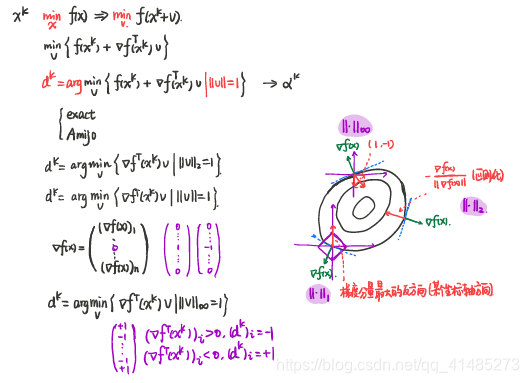中科大-凸优化 笔记(lec47)-最速下降法
本文共 520 字,大约阅读时间需要 1 分钟。
全部笔记的汇总贴(视频也有传送门):
一、梯度下降法
d k + 1 = − ∇ f ( x k ) f ( x k + 1 ) − P ∗ f ( x k ) − P ∗ ≤ 1 − m M ≤ 1 − min { 2 m γ α m a x , 2 m γ β M } K ∼ log ( f ( x k ) − P ∗ ) 线 性 收 敛 d^{k+1}=-\nabla f(x^k)\\\frac{f(x^{k+1})-P^*}{f(x^k)-P^*}\le1-\frac mM\le1-\min\{2m\gamma\alpha_{max},\frac{2m\gamma\beta}M\}\\ K\sim \log(f(x^k)-P^*)\;\;\;\;\;线性收敛 dk+1=−∇f(xk)f(xk)−P∗f(xk+1)−P∗≤1−Mm≤1−min{ 2mγαmax,M2mγβ}K∼log(f(xk)−P∗)线性收敛
二、最速(陡)下降法

三、Gradient与Steepest Gradient的变种
1)坐标轮换法

2)若 f ( x ) f(x) f(x)在某些点不可微

例:

下一章传送门:
转载地址:http://aepq.baihongyu.com/
你可能感兴趣的文章
Nginx+Keepalived+LVS集群实战
查看>>
Nginx+Keepalived实现简单版高可用主备切换
查看>>
Nginx+Lua 开发高性能Web应用实战
查看>>
nginx+mysql+redis+mongdb+rabbitmq 自动化部署脚本
查看>>
nginx+php的搭建
查看>>
nginx+tomcat+memcached
查看>>
nginx+tomcat单个域名及多个域名配置
查看>>
Nginx+Tomcat实现动静分离
查看>>
nginx+Tomcat性能监控
查看>>
nginx+uwsgi+django
查看>>
nginx+vsftp搭建图片服务器
查看>>
Nginx-http-flv-module流媒体服务器搭建+模拟推流+flv.js在前端html和Vue中播放HTTP-FLV视频流
查看>>
nginx-vts + prometheus 监控nginx
查看>>
Nginx/Apache反向代理
查看>>
Nginx: 413 – Request Entity Too Large Error and Solution
查看>>
nginx: [emerg] getpwnam(“www”) failed 错误处理方法
查看>>
nginx: [emerg] the “ssl“ parameter requires ngx_http_ssl_module in /usr/local/nginx/conf/nginx.conf:
查看>>
nginx:Error ./configure: error: the HTTP rewrite module requires the PCRE library
查看>>
Nginx:objs/Makefile:432: recipe for target ‘objs/src/core/ngx_murmurhash.o‘解决方法
查看>>
nginxWebUI runCmd RCE漏洞复现
查看>>